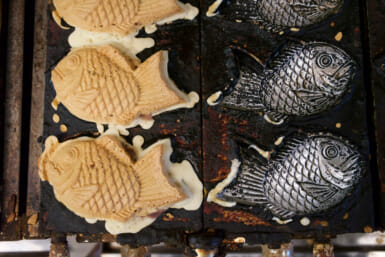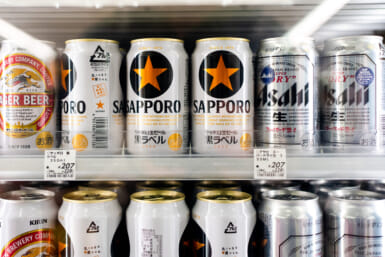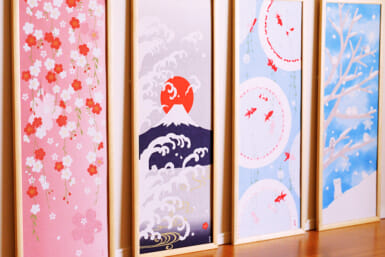A performance of food
by Robert Forrest
An Alsace white spills into small glasses, its cold yellow bronzed against bamboo. Apple juice under rape blossom warms the nose and a slight bitterness curls the tongue: glasses are raised to act one. Sitting on a purple saucer a glass coronet appears, sandwiching ice and cooling the soup.
Edamame damply enters, tasting smoked and scattered with orbs of caviar kicked by a lemon-tomato. Not lemon. Not tomato. Something inbetween that confuses us both while introducing kanji for the latter. It spells the start of scene two.
Strewn like gems before us, trinkets of food menu of all Japan has to offer. A wide plum glaze become props for the kaiseki course; a dense tasting isolates the bare cream centered in the plate and a flower perches atop thick acrylic steps. Ruddy petals reveal a jewel seemingly placed by Botticelli and a miso-soaked yolk is born, its marinade leaving a draft plate, a stem-like skewer lies, three thick signet of timber within a cheese-like ball. From Uffizi back to rings slid on: roe and seaweed wrapped in cucumber sit on the shoulders of salmon hakata, and beside both a yellow sapphire of opaque pumpkin within translucent jelly like the vases of Shiro Kuramata. The comparison fits, for this is avant-garde food the likes of which I did not expect to see beyond the bubble. It would veer towards kitsch were it not so immaculate, not so sincere; food you can set your watch to, owing to how carefully the seasons are co-ordinated in the kitchen.
A curtain falls on the jewelry and a black lacquer pot appears. Opening to a secret garden, vivid green glades dance in the mallow soup like nymphs. Heaven is held in the grilled sea-bass, aubergine sliced beneath. Again you try to capture it, perfecting the image in your mind: fish to the left, aubergine a bit above, mushroom, cucumber, yuzu peel… Blink, and another prop is gone and see now the stars sparkling in the serum-like surface, times for another midsummer night’s dream.
Turn to the program and see the next act, for two glass swans float in front. Skirting each on their semi-circle lake, a pair of golden leaves touch the water, Midas puts on his gloves to place flaked fish and plum on white shredded seaweed, fine as a mermaid’s hair, Inside each swan is more fish, wings coddling plump sashimi inbetween; scallop next to tuna next to flounder. Sweet, gentle, rich, while extraordinary, the tuna dissolves before you bite. Again, the next piece, knowing the third is the last; yet despite knowing the yearning that awaits, patience seems impossible.
Rattan-like glass supports the next plate, a circle as gold as corn. Inside stands squid, komelon courgette, and a prawn head with fresh water still in his veins, They lean against each other, spotted with black beans; I grip one with the courgette. But before you eat, look: the glaze of the section shines like a mirror, Understand now how sharp the knife was that cut it and the care taken by Chef Kimura who sliced it.
From stage to station, the scene before us is like miniatures for a model railway. A small crab, deepfried, stands with one fist raised over a tender beam of sweet potato, while two tiny tubers sit like mittens on pine needles, their flavor lingering like an early mist around cedars. Two squares of beef rest lazily close by, suitcases, perhaps, for the crab before us. It’s shell seems glazed and his whole body cracks, for everything is put in at once, and as legs snap and torso opens so tongue is taken to river and back. But enter the boundary between the two slip away. Meat in my that marbled steak with its juniperberry sauce and feel mouth, all words are displaced, texture dense like wet mink. The ruddy taste is smooth, sudden—and gone
too soon.
Fish follows meat follows fish. Lightly battered and deep fried sweet ayu, three slim squiggles spiral from the center of a ceramic fan, the crunch of summer salad beneath. Initially I expect shishamo but this is dispelled; crisper, denser, more brittle. The fish suiter the salad perfectly, and even I tried a micro-tomato grinning from the leaves.
I almost forgot: one extra course slipped inside the labyrinthine menu. Sea-urchin tofu. Neither ingredient I find attractive alone, but united they are brilliant. Rich, the foot of the soft cube is dampened by wasabi apsic. Together they are unlike anything I have had before and having already said ‘rich’, I struggle to describe it now. The starch course arrives soon, showing that the end is not far: sushi for me, pickles and youto porridge for she, her rice dish mixing boiled and roasted grains while mine is joined by dark miso soup. Again, stop to observe the perfect proportions of the tray and the angle of its edge that adds intimacy to the fish while allowing space for the soup.
Dessert at last brings the first disappointment: tomatoes, peach, and jelly-topped mango. Tomatoes, you recall, are not my thing, though the micro-tomato did well to tempt. A ceramic pail is also on the table, outsized for the specks of cake within: coffee yokan, Castella sponge cake, bean sweets. The jellied coffee slice is fantastic, yet in this time a tea ceremony has begun—my first. Co-diner is so trained: watch the hand, notice the pause, follow the twist. Frothed in the deep dish before us, our maccha green tea is a shallow pool stark against the earthen glaze. Place on the right hand, two turns with the left, raise, and drink. Eyes meet and the third gulp is slurped. Bitterness battles the sweetness of the cakes in front, the tea’s green disc gently reminding of the soup that seems so long ago.
Photogenic barely begins to describe the food at Kakou, but first you’ll need to be blinkered. Alas this trove is not in Ginza where so many restaurants bow with charm, instead you’ll need a swift taxi to Shinjuku, curtains pulled to the static gloom of silent towers. But make it to your table and open your eyes, for in this bland building lies a masterpiece.
Best table: New tatami rooms are opening soon for groups, otherwise try and get close to the window. Prices: Lunch starts at ¥3,200, dinner from ¥6,500. Our kaiseki course cost ¥14,700 each, wine (a 2003 Riesling), another ¥9,500. Location: Nishi-Shinjuku. Take a taxi blindfolded and go to the Hyatt Regency, stumbling to the third floor. Contact: For reservations call 03-3348-1234 or see www.hyattregencytokyo.com.









